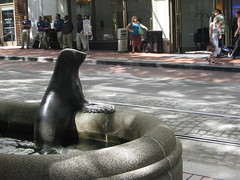A few years ago, intercity bus companies took notice of successful routes that had sprung up to serve Chinatown in New York. Those companies and a few new ones changed the traditional model of station-to-station service and started curbside departures and arrivals, Internet-supplied tickets, free wifi, comfortable seating and very cheap prices compared to the airlines and Amtrak - prices competitive with driving.
Now a report highlighted by the
American Bus Association, from DePaul University,
The Intercity Bus: America’s Fastest Growing Transportation Mode - 2010 Update on Scheduled Bus Service, examines the numbers, the phenomenal increase in demand, though generally limited to major cities with good public transportation, that outstrips growth for air and long-distance train travel. Megabus alone boasts a one-year growth in ridership of almost 50 percent, with "33% ... a conservative middle-ground estimate of the growth in curbside traffic between the 4th quarter of 2009 and 2010."
Good Service Brings Alternative to Car Use and Ownership
Though Amtrak pointed to much more modest ridership increases this past year, Amtrak does not have the luxury of adding service and destinations very easily. The bus phenomenon of the last few years demonstrates the potential demand for long-distance service even in places where that demand has not been addressed. Indeed, the bus phenomenon also shows that for "discretionary riders" a nice atmosphere goes a long way, even without the guarantee of on-time arrival that a train generally delivers.
The report makes the rather large claim that:
curbside buses encourage “transit lifestyles” that place comparatively little emphasis on single-occupant automobile travel (and more emphasis on common-carrier providers) and thus apparently lower carbon footprints per mile traveled.
I think that intercity buses are a piece of the mobility puzzle for many people, a piece that means a car is not a necessity for everyone. The buses also provide a cost-effective way for families to reduce car use, which the train and air travel do not provide, a fact in evidence on the highways during the Thanksgiving weekend and the winter holidays every year.
Sea of Buses
In contrast to even a few years ago, now when you are entering the Lincoln Tunnel to head into the city for Thanksgiving, you see a sea of buses, a good percentage of which are these intercity carriers. And to what do we owe this recent change in the mobility landscape? A flexible private sector that has the ability to make changes without the delay of regulatory changes, infrastructure building and repair, and the other factors that slow down public endeavors. Not saying the private sector can do it all, just that this is a good example of its role in publicly-available transportation as well as the insights into markets that the private sector provides and that other public and private modes can learn from.
Deviating from Private Car Ownership
And intercity buses are not the only part of the private market that is seeing increases, creative car sharing businesses are being developed and spreading. Still an urban phenomenon, companies like Flex Car are branching out into more cities.
RelayRides adds a new type of business model to the mix. The company, backed by Google, enables people to rent out their cars to friends or strangers for a nominal fee with a standard agreement that includes an insurance arrangement.
Read about one person's experience in the Cambridge area. It started in Cambridge and is commencing service in San Francisco.
Different Picture in the Heartland
In the heartland of South Dakota, the availability of mobility options is a very different situation than in the urban centers on the East and West coasts. This is not a transit-rich area; in fact, for people with disabilities, the need is all too real.
Assessing Existing and Needed Community Transportation for People with Disabilities in North Dakota outlines the challenges - "Adequate shelter from the weather while waiting, inconvenient schedules, and having a place to sit while waiting were most often cited as a major problem for people with disabilities." Added to the list a little more into the report is difficulty of boarding.
These seem like universal design issues. Though adequate shelter, for example, might allow a person with a disability to ride transit, it also makes transit more welcoming to the parent with a toddler and the guy who is considering taking the bus during the winter. Aspects of street accessibility to transit were listed as problems for more than half of the survey respondents, as was safety and travel information.
[T]hose who do not use transit were significantly more likely to say service is not available, transit users were less likely to think they are not capable of riding, and those who used transit in the past but do not anymore were more likely to say they do not have enough information.
The results indicate it is not lack of need that keep people with disabilities from using public transportation. Rather, lack of service, lack of information, thinking they are not capable of riding (whether true or not), and fear of riding can likely explain many of the differences between those who use public transportation and those who do not.
Insights into Quality of Paratransit Service
The report also addresses the challenges of using paratransit and the unique situation of people with cognitive impairments.
Two-thirds of respondents said that service not being available when they need it was a problem; 35% said it was a major problem. Other significant problems were unkept schedules for pickups and drop-offs or long waits, the need for scheduling trips too far in advance, and trip times that are too variable or unpredictable. Respondents were least concerned about the vehicles, in terms of their mechanical condition, accessibility, and seating availability.
This is an insightful and detailed study that would be helpful to anyone in transit or those serving people with disabilities. Really, it shows the opportunities in terms of demand and advances in quality of life that mobility options, sometimes the synergy of pedestrian-friendly streets and transit, sometimes other options, can provide.
Spreading the Seedlings of Creativity
I think that the innovations of the private market in cities, the willingness of Americans all over the country to vote for more public transportation funding, and the increasing unattractiveness of a fuel-intensive lifestyle will spur changes in places like South Dakota. Maybe different models of volunteer driver programs and vanpooling are just around the corner for rural areas and other places where people do not wish to or are unable to drive.
Here's to allowing Americans all over the country to have more and better mobility options. Next year, I want to hear about how you picture mobility; I want to learn from you about places where good transportation choices (be they taxis or shared rides), good street networks and good transit are working. Let's learn from the success stories, build upon them, and adapt them to the amazing quilt of places of we live in.




